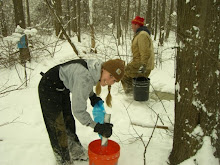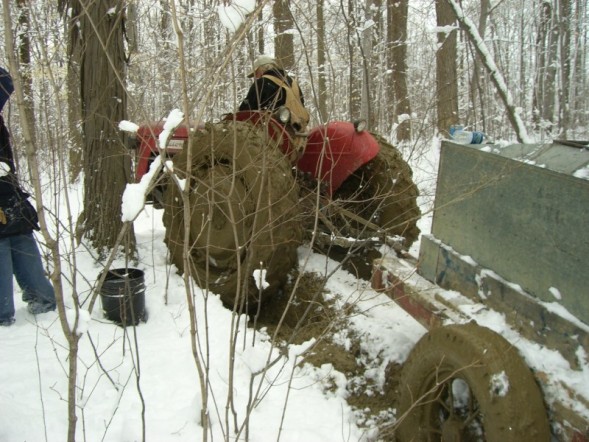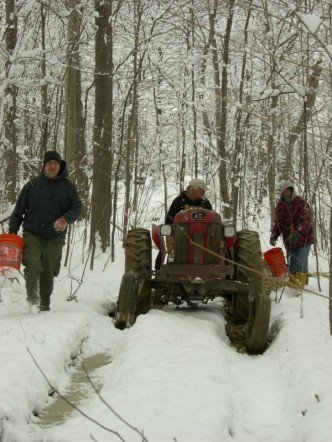
Some History of Maple Production
Maple syrup production goes so far back in American history. Most historians accept the idea that the Indians taught it to the early settlers.
American Indians, however, were accomplished woodsmen that used what they could from their surroundings. They were also very observant; they had to be to survive. They discovered herbs for flavoring food and for medicinal purposes. They used tobacco in their peace pipes. At the end of winter, when all the stored grain and vegetables were gone, the Indians had plenty of motivation to find some variety in their diet and to use what they could to keep warm and survive. Once the Indians boiled the excess water out, the maple sugar that was left could be a source of energy and flavoring that they could store in cakes to use during the rest of the year.
Indian Names
Different Indians had different names for the maple tree and its products. The Algonquin called maple sugar sinsibuckwud. The Ojibway said sheesheegummavvis, meaning "sap flows fast." The Cree called the maple tree sisibaskwattick. The Anishinabe of Minnesota called it aninaatig ahfiwaagamizigan (maple syrup).
The Legends
Indian tribes share various legends about how maple syrup was first made.
Nokomis
The Legend of Nokomis (the land), tells about Nokomis' granddaughter, Manabush tasting the drips after Nokomis had tapped the maple tree to collect syrup. Manabush felt that men would get lazy if all they had to do was to poke the tree, so she grabbed a bucket of water, climbed the maple tree and poured water into the center of the tree, diluting the sweet sap to only 1% to 2% sugar, She made it necessary for men to always work hard to get the syrup.
Glooskap
A similar legend. called the legend of Glooskap tells that the Creator had long ago filled the maple trees with syrup that flowed year-round. Glooskap known by different names to different tribes (Gluscabi. Kuloscap, Manabozho, Odzihozo, or Djokabesh), comes along to one of his People's villages. There are no cooking fires and the gardens are overgrown. The children and dogs don't run out to meet him. Glooskap finds the people in the maple grove, lying down under the maple trees with theireyes closed, letting the sweet sap drip into their open mouths. Dipping into the nearby lake with a birchbark bucket he reaches up and fills the trees with water, thereby diluting the sap. "Rise up, People. The trees are no longer filled with the maple syrup the Creator gave to you. It is only watery sap. Now you will have to hunt and fish and go back to growing your corn, beans and squash."
The Algonquin Chief
A different legend relates the experience of an Algonquin chief He struck a maple tree with his axe one day. His wife saw the treewound dripping. She collected the sap in a wooden bucket and used it to boil the meat for supper. Both the chief and his wife were amazed at the sweetness of the meat that night.
Iriquois
An Iriquois legend simply says that one of their youths watched a squirrel run up a maple tree and bite off a twig. The squirrel licked the sap off the twig. When the Iriquois youth tried the same, he found the sap was sweet. Canadians have observed red squirrels running around from maple tree to maple tree nipping and creating deep wounds. After the wounds have exuded some sap, the squirrels return and eatthe sugar crystals.
The Indians observed their surroundings. As forest dwellers, they had developed quite a sophisticated forest technology. If squirrels could do it, the Indians could definitely build on the squirrels' tactics.
Indian Sugar Production
For centuries Indians have tapped maples, gashed the bark under the tap in a V-shape and put out large birchbark bowls under the tap for collection. Earlier Indians would pour the sap into a hollowed out log or birchbark or clay kettle and drop hot rocks into the cooking vat until most of the water was boiled away. You can only imagine the dark color and the strong flavor syrup produced in this manner would possess. Later Indians would pour the sap into a clay or iron kettle held over a campfire, this lead to a better product where the maple flavor was more pronounced.
Sugar Camps
Eastern woodland natives no matter how far they wandered in the winter for food could return to the maple groves, their ancestral "sugar camps." each spring and start the tapping process all over again.
Indian Sugar
Early White explorers wrote about the Indians having three types of maple sugar. "Grain Sugar" was a coarse granulated sugar similar to our brown sugar. "Cake Sugar- was poured into wooden molds to make blocks or rakes. "Wax Sugar" was extra thick sugar that was poured over snow, which is what we simply call "sugar on snow." Indeed, a few, very old maple trees show indications that the Indians were tapping long before the Europeans touched the American shoreline.
Settlers Sugar Production
17th and l8th Century
When the Europeans came to Eastern Canada 300 years ago they noticed the Indians used a dark sugar with a distinct taste-the first kind of sugar produced in North America, The Indians taught the settlers how to collect maple sap, and the settlers added their own technology to the process. The Europeans used their augers to bore the tap holes, devised wooden spiles (spouts), hung wooden buckets from the spiles, and used their iron kettles to boil the sap.
At this time, maple sugar was a major source of high grade sugar for the French settlers. Imported white sugar was extremely expensive and hard to get. During these 200 years, Americans boiled virtually all of the sap they collected down into sugar. This was done as the Maple syrup would not keep well, however the sugar kept indefinitely.
19th Century
During the 1860s, a combination of developments pushed maple production to its peak. The Civil War soldiers desperately needed a source of good food that wouldn't spoil during shipment and storage. Soon, sheet metal began rolling out of American foundries, making all sorts of new applications possible. Among the first was the tin can. Not only did the can help the cause of the Civil War soldier, it was also a boon for sugarmakers who could now preserve maple syrup to use and sell year-round. Metal sap pails followed with lids to keep debris from falling into the sap.
By the 1900s, sugarmakers had devised a flat-bottomed pan with baffles and channels in the bottom. With this method the heat from the fire could make contact with a larger volume of sap and boil the sap down much faster, hence the flue pan was invented. These were the precursors of the modern evaporators.
20th Century
In 1959 plastic pipeline for use in maple sap collection was invented. For twenty years or so developers struggled with various problems with the plastic tubing. By the time of the energy crisis in the 1970s, however, plastic tubing's problems had been straightened out.
Because of the oil crisis in the 70’s, Canadian and United States agriculture departments focused on energy-efficient production of maple syrup. With the addition of vacuum pumps to the plastic tubing maple producers could now make even slow runs worth the effort to fire up the evaporators. The trees still had to be tapped and the pipeline strung, but the maple producer did not have to enlist a large crew of gatherers to work through the sugarbush and collect the sap from each bucket. The sap from each tap now runs by gravity through the plastic tubing downhill to a collecting tank, ready to be collected and taken to the sugarhouse.
In the 1970s, some sugarmakers starting using a process called reverse osmosis. This process separates water from water-soluble solids and can reduce the boiling process in half or more.
(all info in this post compliments of Green Mountain Maple Sugar Refining Company)




